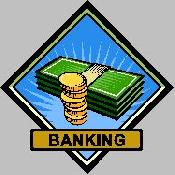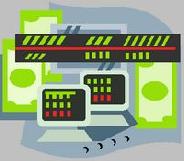
 |
|
| Financial Terms | |
| Payroll Stabilization |
|
Information about financial, finance, business, accounting, payroll, inventory, investment, money, inventory control, stock trading, financial advisor, tax advisor, credit.
Main Page: finance, accounting, credit, inventory control, investment, money, payroll, financial advisor, |
Definition of Payroll Stabilization
Payroll StabilizationThis calculation is used by states to determine the unemployment
Related Terms:Payroll expenseThe amount paid to employees for services rendered; synonymous with salary expense and wage expense. Payroll journalA journal used to record the payroll of a company. Payroll tax expenseThe amount of tax associated with salaries that an employer pays to governments (federal, state, and local). Payroll taxes payableThe amount of payroll taxes owed to the various governments at the end of a period. Payroll CycleThe period of service for which a company compensates its employees. Payroll RegisterA report on which is summarized the wage and deduction information Annual fund operating expensesFor investment companies, the management fee and "other expenses,"  Expense ratioThe percentage of the assets that were spent to run a mutual fund (as of the last annual ExpensedCharged to an expense account, fully reducing reported profit of that year, as is appropriate for GENERAL-AND-ADMINISTRATIVE EXPENSESWhat was spent to run the non-sales and non-manufacturing part of a company, such as office salaries and interest paid on loans. OPERATING EXPENSESThe total amount that was spent to run a company this year. SELLING EXPENSESWhat was spent to run the sales part of a company, such as sales salaries, travel, meals, and lodging for salespeople, and advertising. VARIABLE EXPENSESThose that vary with the amount of goods you produce or sell. These may include utility bills, labor, etc. ExpensesThe costs incurred in buying, making or producing goods and services. Accrued expenses payableexpenses that have to be recorded in order for the financial statements to be accurate. Accrued expenses usually do not involve the receipt of an invoice from the company providing the goods or services. Cash receipts journalA journal used to record the transactions that result in a debit to cash.  Depreciation expenseAn expense account that represents the portion of the cost of an asset that is being charged to expense during the current period. ExpensesCosts involved in running the company. JournalizingThe process of taking a transaction and putting it into a form that allows it to be recorded in the accounting records. Office expenseThe amount of expense incurred for the general operation of an office. Payroll tax expenseThe amount of tax associated with salaries that an employer pays to governments (federal, state, and local). Prepaid expensesexpenses that have been paid for but have not yet been used up; examples are prepaid insurance and prepaid rent. Purchases journalA journal used to record the transactions that result in a credit to accounts payable. Rent expenseThe amount of expense paid for the use of property. Salary expenseThe amount paid to employees for services rendered; synonymous with payroll expense and wage expense. Sales journalA journal used to record the transactions that result in a credit to sales. Specialized journalsjournals that are used to aid in segregating duties and making the accounting function efficient.  Wage expenseThe amount paid to employees for services rendered; synonymous with salary expense and payroll expense. accrued expenses payableThe account that records the short-term, noninterest- fixed expenses (costs)expenses or costs that remain the same in amount, revenue-driven expensesOperating expenses that vary in proportion to unit-driven expensesexpenses that vary in close proportion to changes variable expensesexpenses that change with changes in either sales volume ExpenseThe reduction in value of an asset as it is used for current company operations. Journal entryThe formal accounting entry used to identify a business transaction. The Operating expenseAny expense associated with the general, sales, and administrative Prepaid expenseAn expenditure that is paid for in one accounting period, but which Current Income Tax ExpenseThat portion of the total income tax provision that is based on Deferred Income Tax ExpenseThat portion of the total income tax provision that is the result Income Tax ExpenseSee income tax provision. Fixed ExpensesCost of doing business which does not change with the volume of business. Examples might be rent for business premises, insurance payments, heat and light. management expense ratio (MER)The total expenses expressed as an annualized percentage of daily average net assets. MER does not include brokerage fees and commissions, which are also payable by the Fund. Operating ExpensesThe amount of money the company must spend on overhead, distribution, taxes, underwriting the risk and servicing the policy. It is a factor in calculating premium rates. Related to : financial, finance, business, accounting, payroll, inventory, investment, money, inventory control, stock trading, financial advisor, tax advisor, credit. |